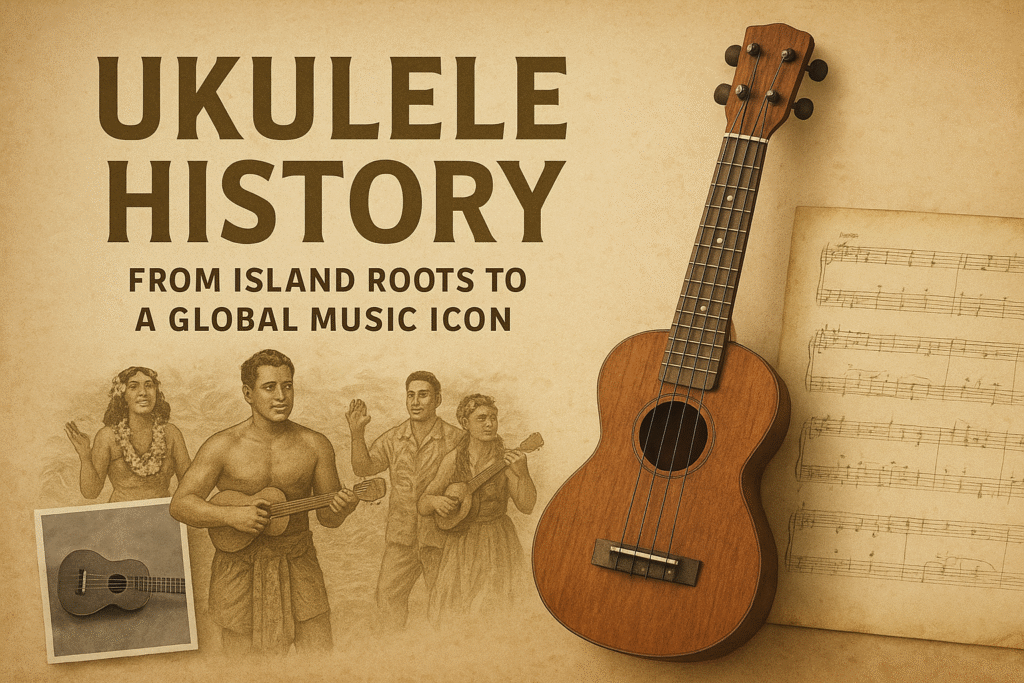The ukulele is more than just a small, four-stringed instrument with a cheerful sound. Its history tells a story of cultural exchange, identity, and global influence. To understand the ukulele’s history, we need to look at how it was born from Portuguese roots, transformed into a Hawaiian treasure, and eventually spread across the world to become a symbol of joy and simplicity in music. Learning about its past is not only fascinating but also helps us appreciate why this instrument continues to be loved by beginners, professionals, and audiences everywhere.
The journey of the ukulele highlights how music can cross borders, carry traditions, and adapt to new styles over time. Its history reflects creativity, resilience, and the power of music to bring people together.
The Origins of the Ukulele
The ukulele’s story begins in the late 19th century, when Portuguese immigrants arrived in Hawaii, bringing with them small guitar-like instruments such as the machete de braga and the cavaquinho. These instruments had a bright, lively sound and quickly caught the attention of local Hawaiians.
Hawaiians adapted these imported instruments, making changes to their size, tuning, and playing style. The result was a new instrument, distinct from its European cousins, that came to be known as the ukulele. The name itself is often translated as “jumping flea,” possibly referring to the lively finger movements of early players.
From the beginning, the ukulele was shaped by a blend of cultures — Portuguese craftsmanship and Hawaiian creativity — making it a perfect example of how musical traditions evolve through exchange and adaptation.
The Ukulele in Hawaiian Culture
Once it took root in Hawaii, the ukulele quickly became more than an imported curiosity. It was embraced as a cultural symbol, woven into local traditions and performances. King David Kalākaua, known as the “Merrie Monarch,” played a key role in popularizing the ukulele by including it in royal gatherings, concerts, and celebrations. Under his reign, the instrument became associated with Hawaiian identity and pride.
The ukulele was not just an instrument for entertainment. It became part of storytelling, hula dances, and communal celebrations, making it central to Hawaiian music culture. Its approachable size and cheerful tone made it accessible to both professional musicians and everyday people. Over time, it became inseparable from the sound of Hawaii itself.
Spreading Beyond the Islands
By the early 20th century, the ukulele’s popularity had moved far beyond Hawaii. It reached the mainland United States, where it became a musical sensation. Vaudeville performers and popular musicians introduced the ukulele to audiences eager for something fresh and portable. Its affordability and simplicity made it particularly appealing during the 1910s and 1920s, when it became a household favorite.
The spread didn’t stop there. The United Kingdom also embraced the ukulele, with performers like George Formby in the 1930s making it a part of British entertainment. Its lighthearted charm resonated across cultures, giving the ukulele a global stage.
This expansion transformed the ukulele from a Hawaiian cultural treasure into an international symbol of fun and accessible music. By the mid-20th century, it had already cemented its place in popular music history.
The Instrument’s Evolution Over Time
As the ukulele spread worldwide, it evolved into different forms and sizes. The soprano ukulele is the traditional model, known for its bright, classic sound. The concert ukulele offered a slightly larger body and a richer tone, appealing to players who wanted more volume. The tenor ukulele expanded the range even further, while the baritone ukulele introduced deeper, guitar-like tones.
This evolution allowed the ukulele to adapt to different music styles and player preferences. Its versatility made it suitable for folk, jazz, pop, and even classical arrangements. The changes also reflected the instrument’s journey from a Hawaiian cultural icon to a universal tool for musical creativity.
The Ukulele Revival in Modern Music
Although the ukulele’s popularity dipped during the mid-20th century, it experienced a major revival toward the end of the century and into the 21st. Artists such as Israel Kamakawiwo‘ole, whose version of Somewhere Over the Rainbow captured hearts worldwide, played a huge role in reintroducing the ukulele to global audiences.
The internet and social media gave the ukulele an even bigger boost. Online tutorials, viral performances, and popular covers made the instrument accessible to a new generation. Musicians across genres, from indie bands to pop stars, incorporated the ukulele into their work, further fueling its rise.
This revival is not just about nostalgia. It reflects the instrument’s timeless appeal — its simplicity, portability, and joyful sound make it perfect for modern music culture, where accessibility and authenticity are highly valued.
Why Ukulele History Still Matters Today?
Studying the history of the ukulele is more than a look back at the past. It explains why this small instrument continues to thrive in today’s music world. Its roots in cultural exchange remind us how music travels and transforms. Its role in Hawaiian identity highlights the importance of instruments in shaping cultural pride. Its global spread shows how music can adapt to different contexts and remain relevant.
The ukulele’s story also illustrates how traditional instruments can find new life in modern settings. Understanding this history helps musicians and enthusiasts connect more deeply with the instrument, respecting its origins while appreciating its ongoing influence.
Conclusion
The ukulele’s history is a journey that begins with Portuguese roots, blossoms in Hawaiian culture, and spreads to the world as a symbol of joy, simplicity, and connection. From royal courts in Hawaii to global pop stages, the ukulele has carried with it a spirit of creativity and inclusivity.
Its story is not just about music but about culture, identity, and resilience. Today, when people pick up a ukulele, they are not only playing an instrument but also becoming part of a rich historical tradition that continues to inspire musicians everywhere.
The history of the ukulele reminds us that music, no matter how small or simple the instrument, can make a global impact that lasts for generations.




